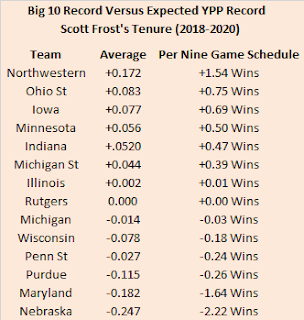Once again, here are the 2021 Big 10 standings.
And here are the APR standings with conference rank in offensive touchdowns, touchdowns allowed, and APR in parentheses. This includes conference games only with the championship game excluded.
Finally, Big 10 teams are sorted by the difference between their actual number of wins and their expected number of wins according to APR.
I use a game and a half as a line of demarcation to determine whether or not a team significantly over or under-performed relative to their APR and by that standard, Iowa and Michigan State over-performed while Penn State and Nebraska under-performed. As it happens, Iowa, Michigan State, and Nebraska all saw their records differ from their expected records based on YPP as well and we went over some reasons for that last week, so we'll just take a quick look at Penn State. The Nittany Lions actually finished with a losing Big 10 record, dropping five of their last seven conference games. The usual suspects are to blame here as Penn State finished 1-4 in one-score conference games. In addition, their other Big 10 loss came by just nine points at Ohio State.
Scott Frost's Track Record at Nebraska
Last week we identified Nebraska as the best BCS/Power 5 team (using Yards Per Play data) to finish with a single conference victory going back to at least 2005. Obviously, if you look at their APR numbers, they were probably one of the best one-win teams by that metric as well. I didn't want to completely rehash last week's post with a different metric, so I decided to take a closer look at how Nebraska has performed through the four seasons of the Scott Frost era and compare that performance to their peers. While I was looking through the data, I noticed Nebraska's significant under-performance in 2021 was not an isolated incident. In fact, the Huskers have underachieved more than any other Big 10 program (in conference play) since Frost's arrival in 2018 (at least relative to their Yards Per Play numbers).
Here's a quick primer on how to read that table. In the past four conference seasons, Northwestern overachieved their expected win percentage (based on YPP) by an average of .172 per season. Prorated out to a nine-game conference schedule that equates to about an extra one and a half wins per seasons. Most teams are pretty close to zero in terms of their average over or under-performance. 11 of the 14 Big 10 teams have over or under-performed by less than one win per season. That's what happens as the sample size of seasons increases. Teams that overachieve one year tend to fall back to average or underachieve the next season. However, Nebraska seems to be a pretty significant outlier in that regard. The Huskers have underachieved on average by nearly .250! That is more than two wins over a full conference season. And while the Huskers were big time underachievers in 2021, that merely continued a trend that began in Frost's first season.
The Cornhuskers have ranked in the bottom quartile in underachievement in each of Frost's four seasons in charge. They can't win close games (5-16 in one-score conference games under Frost) and they turn the ball over too much (-17 turnover margin in 35 conference games Frost has coached). Befitting that poor turnover margin, the Cornhuskers have won the turnover battle in just a quarter of the conference games Frost has coached (9) while committing more turnovers than their opponent nearly twice as often (17). Nebraska simply cannot be as unlucky as they were in 2021. They are destined to improve. But by how much? What is their ceiling? Their national title contending days are long over, but can they even compete for a division title? To do so in 2021, they will have to break a consistent streak of underachievement.





No comments:
Post a Comment